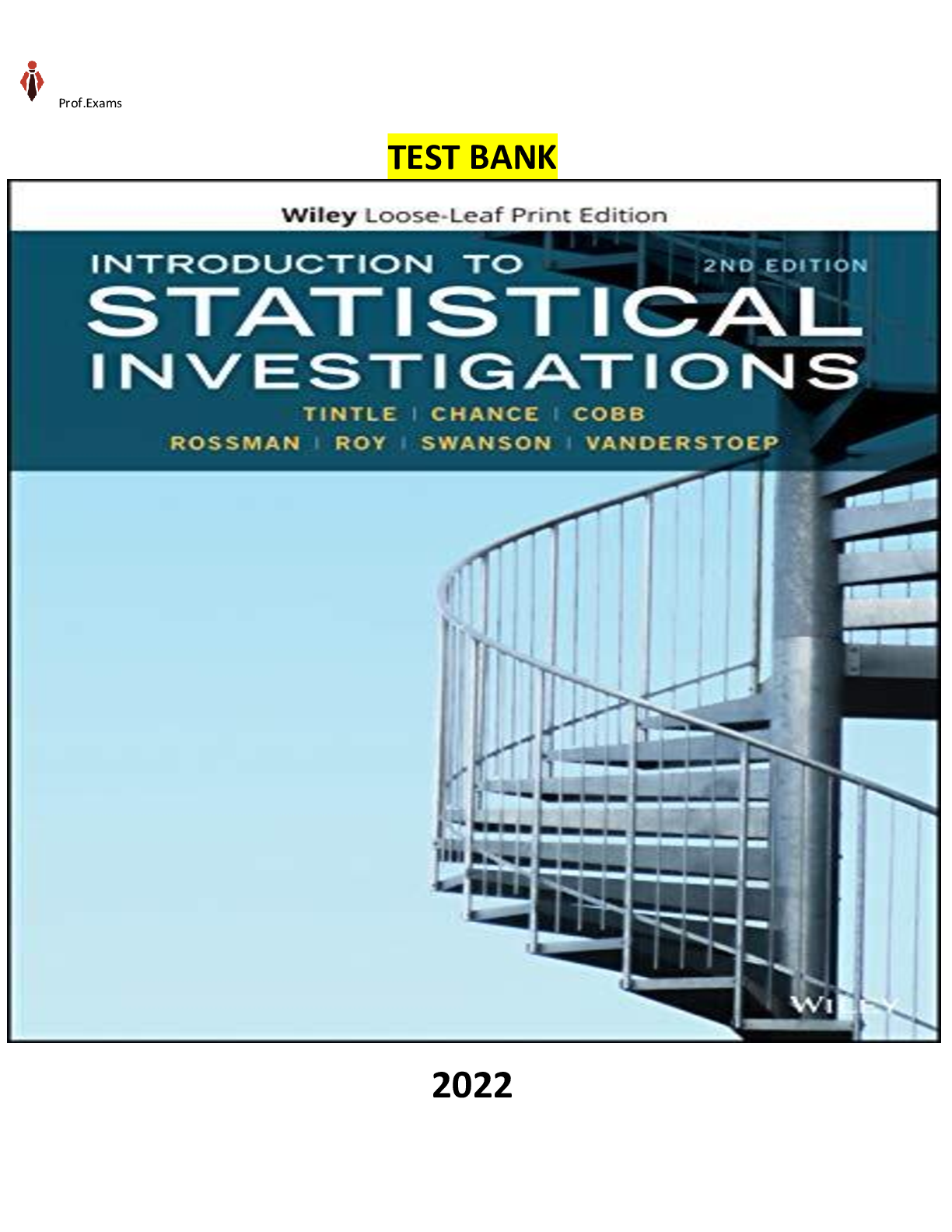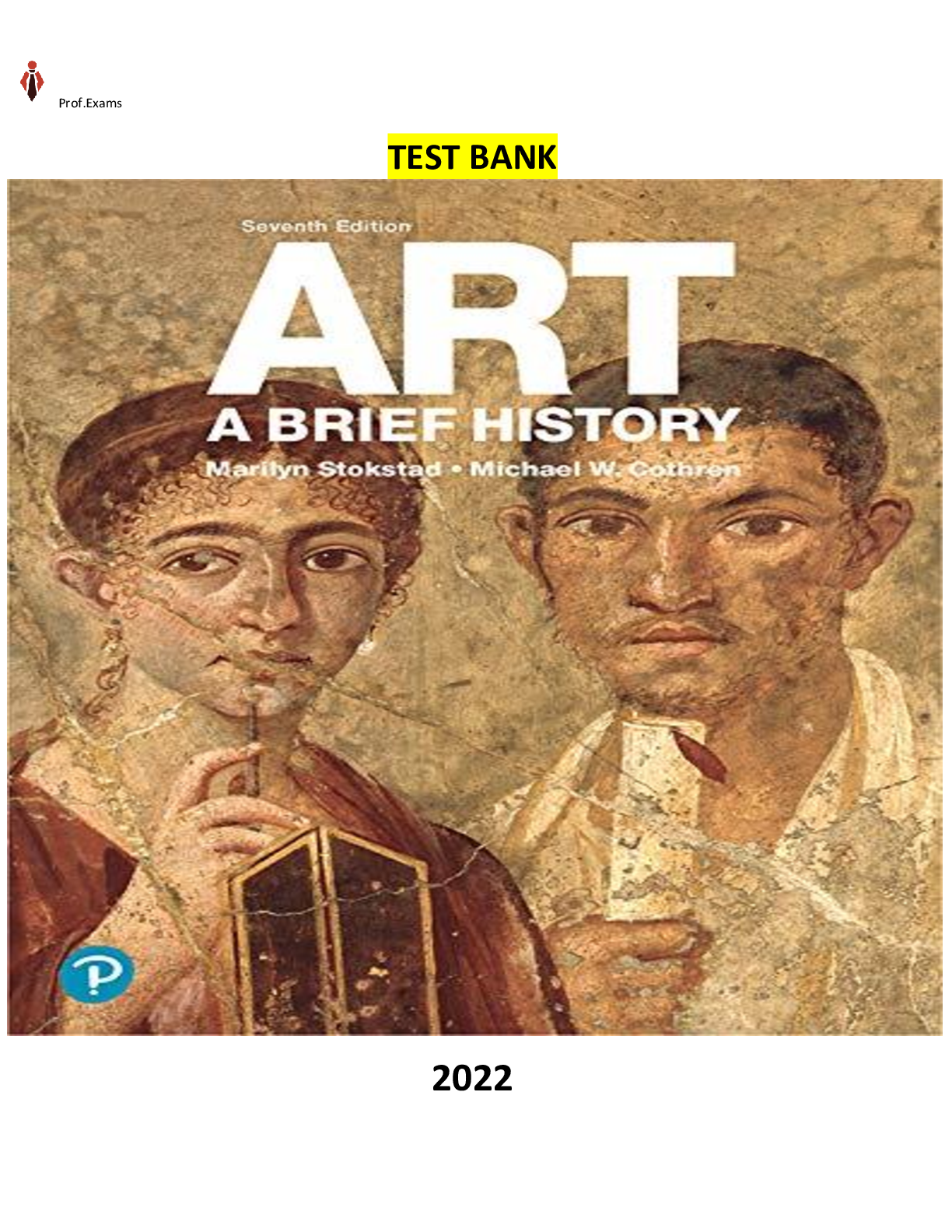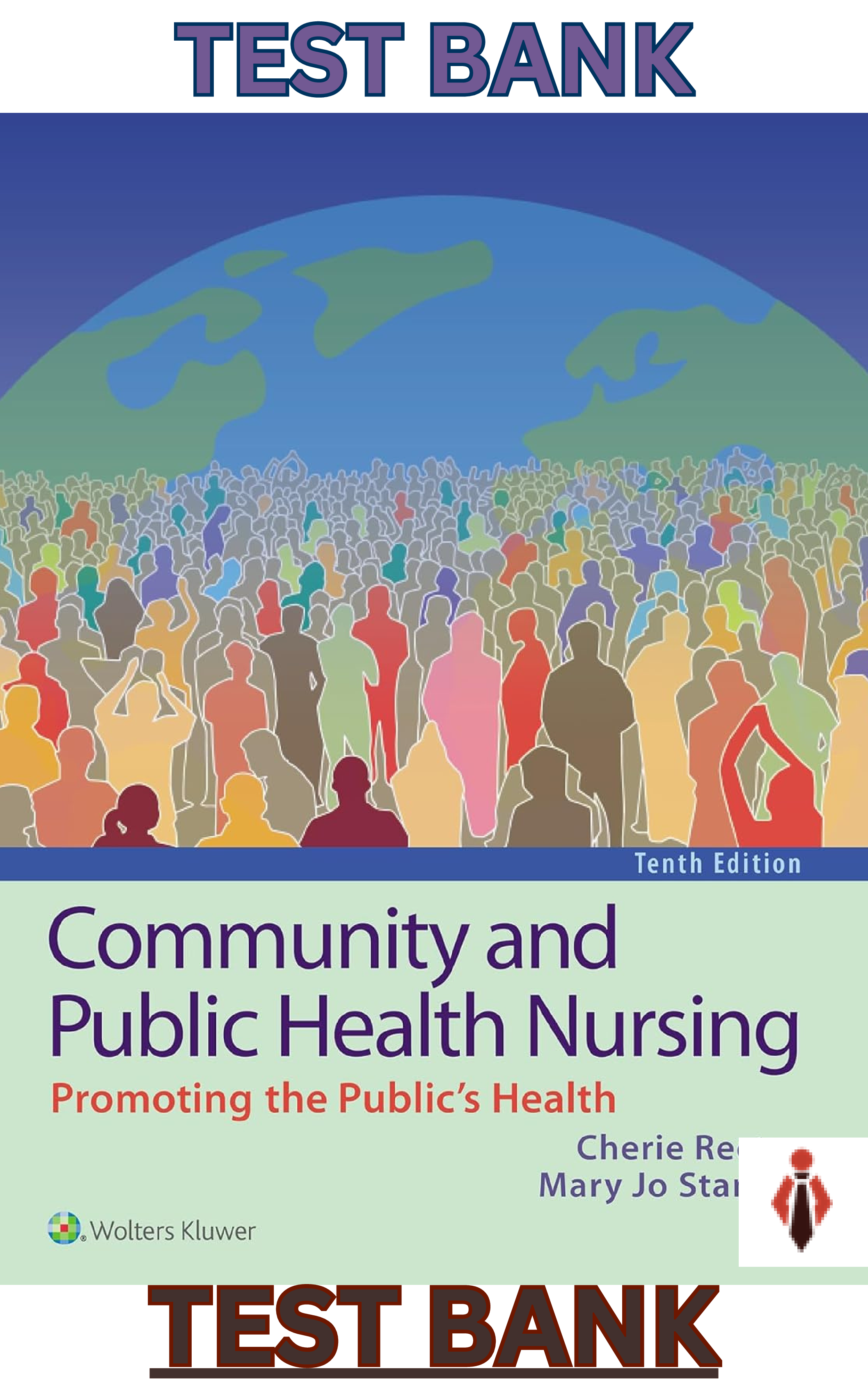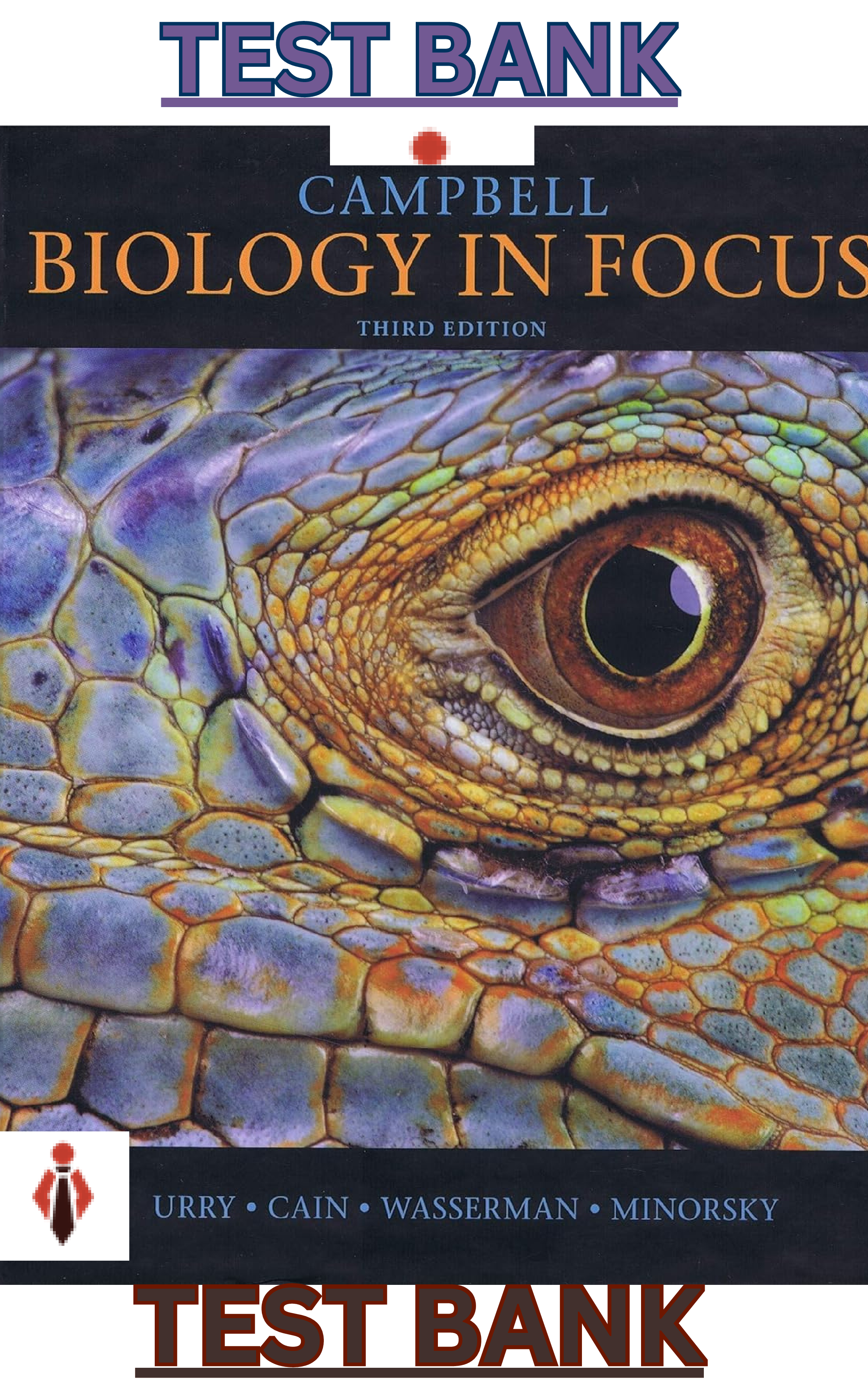Statistics > TEST BANKS > COMPLETE - Elaborated Test Bank for Introduction to Statistical Investigations 2Ed. by N.Tintle, B.C (All)
COMPLETE - Elaborated Test Bank for Introduction to Statistical Investigations 2Ed. by N.Tintle, B.Chance, G.W.Cobb, A.J.Rossman, S.Roy, T.Swanson, J.VanderStoep. ALL Chapters 1-11 Included and updated for 2023
Document Content and Description Below
COMPLETE - Elaborated Test Bank for Introduction to Statistical Investigations 2Ed. by N.Tintle, B.Chance, G.W.Cobb, A.J.Rossman, S.Roy, T.Swanson, J.VanderStoep. ALL Chapters 1-11 Included and updat... ed for 2023 COMPLETE - Elaborated Test Bank for Introduction to Statistical Investigations 2Ed. by N.Tintle, B.Chance, G.W.Cobb, A.J.Rossman, S.Roy, T.Swanson, J.VanderStoep. ALL Chapters 1-11 Included and updated for 2023 TABLE OF CONTENTS Unit 1 Four Pillars of Inference: Strength, Size, Breadth, and Cause 30 1 Significance: How Strong Is the Evidence? 31 Section 1.1: Introduction to Chance Models 32 Example 1.1: Can Dolphins Communicate? 33 Exploration 1.1: Can Dogs Understand Human Cues? 41 Section 1.2: Measuring the Strength of Evidence 45 Example 1.2: Rock-Paper-Scissors 46 Exploration 1.2: Tasting Water 52 Section 1.3: Alternative Measure of Strength of Evidence 57 Example 1.3: Heart Transplant Operations 58 Exploration 1.3: Do People Use Facial Prototyping? 62 Section 1.4: What Impacts Strength of Evidence? 66 Example 1.4: Predicting Elections from Faces? 66 Exploration 1.4: Competitive Advantage to Uniform Colors? 72 Section 1.5: Inference for a Single Proportion: Theory-Based Approach 75 Example 1.5: Halloween Treats 77 Exploration 1.5: Eye Dominance 80 2 Generalization: How Broadly Do the Results Apply? 117 Section 2.1: Sampling from a Finite Population: Proportions 118 Example 2.1: Voter Turnout 119 Exploration 2.1: Sampling Words 126 Section 2.2: Quantitative Data 133 Example 2.2: Sampling Students 134 Exploration 2.2: Sampling Words (cont.) 138 Section 2.3: Theory-based Inference for a Population Mean 143 Example 2.3: Estimating Elapsed Time 143 Exploration 2.3: Sleepless Nights? 150 Section 2.4: Other Statistics 154 Example 2.4: Estimating Elapsed Time (cont.) 154 Exploration 2.4: Backpack Weights 160 3 Estimation: How Large Is the Effect? 187 Section 3.1: Statistical Inference: Confidence Intervals 188 Example 3.1: Can Dogs Sniff Out Cancer? 189 Exploration 3.1: Kissing Right? 194 Section 3.2: 2SD and Theory-Based Confidence Intervals for a Single Proportion 198 Example 3.2: Cyberbullying 198 Exploration 3.2: How Mobile Are We? 203 Section 3.3: 2SD and Theory-Based Confidence Intervals for a Single Mean 207 Example 3.3: Used Cars 207 Exploration 3.3: Sleepless Nights? (cont.) 210 Section 3.4: Factors That Affect the Width of a Confidence Interval 213 Example 3.4: American Cat Ownership 214 Exploration 3.4A: Holiday Spending Habits 216 Exploration 3.4B: Reese’s Pieces 218 4 Causation: Can We Say What Caused the Effect? 245 Section 4.1: Association and Confounding 246 Example 4.1: Night Lights and Nearsightedness 247 Exploration 4.1: Home Court Disadvantage? 250 Section 4.2: Observational Studies Versus Experiments 252 Example 4.2: Lying on the Internet 253 Exploration 4.2: Have a Nice Trip 257 Unit 2 Comparing Two Groups 278 5 Comparing Two Proportions 279 Section 5.1: Comparing Two Groups: Categorical Response 280 Example 5.1: Buckling Up? 280 Exploration 5.1: Murderous Nurse? 285 Section 5.2: Comparing Two Proportions: Simulation-Based Approach 288 Example 5.2: Swimming with Dolphins 289 Exploration 5.2: Is Yawning Contagious? 297 Section 5.3: Comparing Two Proportions: Theory-Based Approach 304 Example 5.3: Parents’ Smoking Status and Their Babies’ Sex 305 Exploration 5.3: Donating Blood 311 6 Comparing Two Means 346 Section 6.1: Comparing Two Groups: Quantitative Response 347 Example 6.1: Geyser Eruptions 347 Exploration 6.1: Cancer Pamphlets 350 Section 6.2: Comparing Two Means: Simulation-Based Approach 354 Example 6.2: Dung Beetles 354 Exploration 6.2: Lingering Effects of Sleep Deprivation 363 Section 6.3: Comparing Two Means: Theory-Based Approach 369 Example 6.3: Violent Video Games and Aggression 369 Exploration 6.3: Close Friends 378 7 Paired Data: One Quantitative Variable 407 Section 7.1: Paired Designs 408 Example 7.1: Can You Study with Music Blaring? 408 Exploration 7.1: Rounding First Base 411 Section 7.2: Simulation-Based Approach to Analyzing Paired Data 413 Example 7.2: Rounding First Base (cont.) 414 Exploration 7.2: Exercise and Heart Rate 420 Section 7.3: Theory-Based Approach to Analyzing Data from Paired Samples 425 Example 7.3: Dad Jokes? 425 Exploration 7.3: Comparing Auction Formats 431 Unit 3 Analyzing More General Situations 456 8 Comparing More Than Two Proportions 458 Section 8.1: Comparing Multiple Proportions: Simulation-Based Approach 459 Example 8.1: Coming to a Stop 460 Exploration 8.1: Recruiting Organ Donors 466 Section 8.2: Comparing Multiple Proportions: Theory-Based Approach 470 Example 8.2: Sham Acupuncture 471 Exploration 8.2A: Conserving Hotel Towels 476 Exploration 8.2B: Nearsightedness and Night Lights Revisited 480 Section 8.3: Chi-Square Goodness-of-Fit Test 484 Example 8.3: Fair Die? 484 Exploration 8.3: Are Birthdays Equally Distributed Throughout the Week? 490 9 Comparing More Than Two Means 519 Section 9.1: Comparing Multiple Means: Simulation- Based Approach 520 Example 9.1: Comprehending Ambiguous Prose 520 Exploration 9.1: Exercise and Brain Volume 525 Section 9.2: Comparing Multiple Means: Theory-Based Approach 529 Example 9.2: Recalling Ambiguous Prose 530 Exploration 9.2: Comparing Popular Diets 538 10 Two Quantitative Variables 565 Section 10.1: Two Quantitative Variables: Scatterplots and Correlation 566 Example 10.1: Why Whales Are Big, but Not Bigger 567 Exploration 10.1: Height and Winning at Tennis 571 Section 10.2: Inference for the Correlation Coefficient: Simulation-Based Approach 576 Example 10.2: Exercise Intensity and Mood Changes 576 Exploration 10.2: Draft Lottery 580 Section 10.3: Least Squares Regression 585 Example 10.3: Height and Winning at Tennis (cont.) 585 Exploration 10.3: Predicting Height from Footprints 590 Section 10.4: Inference for the Regression Slope: Simulation-Based Approach 596 Example 10.4: Do Students Who Spend More Time in Non-Academic Activities Tend to Have Lower GPAs? 596 Exploration 10.4: Predicting Brain Density from Number of Facebook Friends 599 Section 10.5: Inference for the Regression Slope: Theory-Based Approach 601 Example 10.5A: Predicting Heart Rate from Body Temperature 602 Example 10.5B: Smoking and Drinking 606 Exploration 10.5: Predicting Brain Density from Number of Facebook Friends (cont.) 608 Unit 4 Probability (Online) 11-1 11 Modeling Randomness 11-2 Section 11.1: Basics of Probability 11-3 Example 11.1: Random Ice Cream Prices 11-3 Exploration 11.1: Random Babies 11-8 Section 11.2: Probability Rules 11-10 Example 11.2: Watching Films 11-11 Exploration 11.2: Random Ice Cream Prices (cont.) 11-15 Section 11.3: Conditional Probability and Independence 11-19 Example 11.3: Watching Films Revisited 11-20 Exploration 11.3A: College Admissions 11-25 Exploration 11.3B: Rare Disease Testing 11-28 Section 11.4: Discrete Random Variables 11-30 Example 11.4: A Game of Chance 11-30 Exploration 11.4: Traffic Lights 11-35 Section 11.5: Random Variable Rules 11-38 Example 11.5: A Game of Chance Revisited 11-38 Exploration 11.5: Skee-Ball 11-45 Section 11.6: Binomial and Geometric Random Variables 11-50 Example 11.6: Time to Leave the Nest? 11-52 Exploration 11.6: Clueless Quiz 11-59 Section 11.7: Continuous Random Variables and Normal Distributions 11-63 Example 11.7: Heights of Adult Women 11-65 Exploration 11.7A: Birthweights 11-69 Exploration 11.7B: Run, Girl, Run! 11-71 Section 11.8: Revisiting Theory-Based Approximations of Sampling Distributions 11-72 Example 11.8A: Time to Leave the Nest Revisited 11-74 Example 11.8B: Intelligence Test 11-75 Exploration 11.8A: Racket Spinning 11-77 Exploration 11.8B: Random Ice Cream Prices (cont.) 11-77. [Show More]
Last updated: 2 years ago
Preview 1 out of 160 pages

Buy this document to get the full access instantly
Instant Download Access after purchase
Buy NowInstant download
We Accept:

Reviews( 0 )
$27.50
Can't find what you want? Try our AI powered Search
Document information
Connected school, study & course
About the document
Uploaded On
Apr 10, 2023
Number of pages
160
Written in
Additional information
This document has been written for:
Uploaded
Apr 10, 2023
Downloads
0
Views
75


























